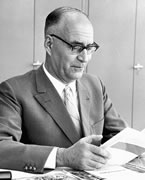Prof. Dr.h.c.
Felix Wankel
Born: 13 August 1902, Lahr
Died: 9 October 1988, Heidelberg
"Sometimes I am being overwhelmed by an idea, by a project. Then I work feverishly without taking time for anything else ... "
After many years of research, Wankel found the solution for a new type of engine. In contrast to the conventional reciprocating piston engine, where the piston performs a linear movement, the Wankel engine uses a so-called rotating or rotary piston revolving in the combustion chamber.
Workshop and racing boats
On leaving school, Wankel started a vocational training at a publishing house in Heidelberg. At the same time, he set up a workshop together with friends, where they assembled racing cars and racing boats from scrap parts. In 1924 they built the "Teufelskäfer" (Devil's Beetle), a three-wheel streamlined vehicle that reached a maximum speed of 110 km/h.
At that time, he was already fascinated by the idea of designing an engine that would perform rotating movements. Wankel assumed that new engine types might be based on fully sealed, gas-tight combustion chambers. He worked for ten years to find a solution.
From 1936 the Reichsluftfahrtministerium (Air Ministry) funded his research, enabling him to set up a test centre. Wankel developed rotary slide valves for aircraft engines, combustion engines for torpedo drives and hydrofoils. In 1944, the first rotary piston compressor successfully performed a test run.
Wankel's institute was seized in 1945. In 1951 he was finally able to set up a new institute to carry on engine research. At that time, his work was funded by motorcycle manufacturer NSU.
An engine featuring a rotating piston was built in 1954. The first "Wankelmotor", type DKM 54, was launched in 1958.
Wankel engine
Conventional reciprocating piston engines have many parts that will be rapidly accelerated and decelerated. The exerted acceleration forces must not exceed a certain value, and consequently set a limit to the engine speed (rpm).
The new idea was to replace linear reciprocating movements by rotational movements. This concept is implemented in the so-called DKM (Drehkolbenmotor ) rotary piston engine.
This design has the following advantages over reciprocating piston engines: improved vibration-free running, compact construction, no valve drive mechanism required, smoother flow of power, reduced weight. The rotary piston performs a double motion: it rotates around its own centre, and the centre revolves around the housing centre. The three apexes of the rotary piston move along a housing wall.
The later KKM (Kreiskolbenmotor) type design constitutes a kinematic reversal of the DKM type. In a KKM type engine, a convex triangular rotor rotates within a static epitrochoidal housing. Intake and exhaust ports are provided in the housing wall. A four stroke cycle (intake - compression - expansion - exhaust) is performed in the chambers between the rotor and the wall. The chamber size varies according to the rotor movement.
Use of the Wankel engine
The first production Wankel powered car was the "NSU Spider" in 1963. Although many firms were very interested in this technology and took licences, the Wankel engine was not widely used. The Japanese car manufacturer Toyo Kogyo Mazda was the only company to pursue the development of the engine.
In the 1970s, Wankel designed the "Zisch" hydrofoil, whose 300 hp Wankel engine allowed to reach maximum speeds exceeding 100 km/h. In 1982, Wankel developed a new rotary piston engine using a novel two stroke cycle. Until his death, Felix Wankel used a Wankel powered NSU Ro 80 car, driven by a chauffeur - the engine builder had never held a driver's licence.
Patent search
To find out more about Felix Wankel's patents, go to DEPATISnet

© Stiftung Landesmuseum für Arbeit und Technik
Patent document DE-952903
"Drehkolbenmaschine mit zwei exzentrisch ineinander gelagerten Läufern"
(PDF - 174 KB)
Barényi . Binnig . Bölkow . Bruch . Dethloff . Fischer . Hell . Lindenmeier . Oberth . v.Ohain . Peter . Quadbeck-Seeger . Ruska . Sauer . Wankel . Winnacker . Zuse
Copyright © Deutsches Patent- und Markenamt 2004
